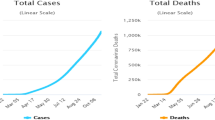Abstract
In 2019 our world was introduced by a pandemic named as corona which had taken a lot of lives, because of which our India has suffered a lot. So we decided to make something which can help peoples to follow the norms of government and can take care of others as well as themselves. Hence we had decided to work on this project. The social distancing among persons are the best solution for avoiding the COVID and thus this paper is based on similar aspects. The paper proposes a solution for maintaining the distance among person as per guidelines by using YOLO based algorithm and proposed a solution as “Social Distancing Detector”. Social distance detector is used to provide information about people who disobey the norms of maintaining the distance between any two persons and provide demarcation by means of red rectangular box for those who are not maintaining the proper distance among themselves whereas segregating other with green rectangle boxes. Thus, social distancing can be monitored through remote location and having clear demarcation.
Access this chapter
Tax calculation will be finalised at checkout
Purchases are for personal use only
Similar content being viewed by others
References
Nepal U, Eslamiat H (2022) Comparing YOLOv3, YOLOv4 and YOLOv5 for autonomous landing spot detection in faulty UAVs. Sensors 22(2):464
Redmon J, Farhadi A (2018) YOLOv3: an incremental improvement, University of Washington. arXiv:1804.02767v1 [cs.CV]
Viraktamath SV, Yavagal M, Byahatti R (2021) Object detection and classification using YOLOv3. Int J Eng Res Technol (IJERT) 10(2):1–6. ISSN: 2278–0181
Huang R, Pedoeem J, Chen C (2018) YOLO-LITE: a real-time object detection algorithm optimized for non-GPU computers. arXiv:1811.05588v1 [cs.CV]
Bochkovskiy A, Wang C-Y, Liao H-YM (2020) YOLOv4: optimal speed and accuracy of object detection. arXiv:2004.10934v1 [cs.CV]
Wang C-Y, Bochkovskiy A, Liao H-YM (2021) Scaled-YOLOv4: scaling cross stage partial network. arXiv:2011.08036v2 [cs.CV]
Zhao Z-Q, Zheng P, Xu S-T, Wu X (2019) Object detection with deep learning: a review. arXiv:1807.05511v2 [cs.CV]
Rajput S, Patni J, Alshamrani S, Chaudhari V, Dumka A, Singh R, Rashid M, Gehlot A, Alghamdi A (2022) Automatic vehicle identification and classification model using the YOLOv3 algorithm for a toll management system. Sustainability 14. https://doi.org/10.3390/su14159163
Aishwarya CN, Mukherjee R, Mahato DK Multilayer vehicle classification integrated with single frame optimized object detection framework using CNN based deep learning architecture. In: 2018 IEEE International conference on electronics, computing and communication technologies (CONECCT), Bangalore, India, pp 1–6. https://doi.org/10.1109/CONECCT.2018.8482366
Song H, Liang H, Li H, Dai Z, Yun X (2019) Vision-based vehicle detection and counting system using deep learning in highway scenes. Eur Transp Res Rev 11:51. https://doi.org/10.1186/s12544-019-0390-4
Martinez-Alpiste I, Golcarenarenji G, Wang Q, Alcaraz C, Jose M (2021) A dynamic discarding technique to increase speed and preserve accuracy for YOLOv3. Neural Comput Appl 33:9961–9973. Springer
Yin X, Sasaki Y, Wang W, Shimizu K (2020) YOLO and K-means based 3D object detection method on image and point cloud. arXiv:2004.11465v1 [cs.CV]
Author information
Authors and Affiliations
Corresponding author
Editor information
Editors and Affiliations
Rights and permissions
Copyright information
© 2023 The Author(s), under exclusive license to Springer Nature Singapore Pte Ltd.
About this paper
Cite this paper
Dumka, A., Chaudhari, V., Gangotkar, D., Ashok, A., Yadav, D. (2023). Social Distancing Detector Using YOLO3 Algorithm. In: Goar, V., Kuri, M., Kumar, R., Senjyu, T. (eds) Advances in Information Communication Technology and Computing. Lecture Notes in Networks and Systems, vol 628. Springer, Singapore. https://doi.org/10.1007/978-981-19-9888-1_50
Download citation
DOI: https://doi.org/10.1007/978-981-19-9888-1_50
Published:
Publisher Name: Springer, Singapore
Print ISBN: 978-981-19-9887-4
Online ISBN: 978-981-19-9888-1
eBook Packages: EngineeringEngineering (R0)




